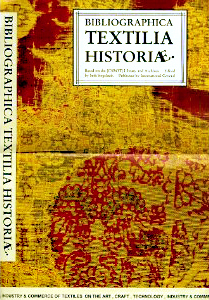 Seth Siegelaub; International General, New York/Amsterdam 1997; 415 S., 35 Illustrationen, Text auf Englisch.
Seth Siegelaub; International General, New York/Amsterdam 1997; 415 S., 35 Illustrationen, Text auf Englisch.
Vor 17 Jahre war diese Bibliographie unter geringer Anteilnahme der Öffentlichkeit erschienen, die seit 2012 nach der Ausstellung „Stuff Matters“ mit historischen Textilien aus der Sammlung des in 2013 verstorbenen Autors bei Raven Row in London als Vorläufer der aktuellen Schwemme mit textilen Objekten in Kunstausstellungen ihre verdiente Aufmerksamkeit erhielt. Ich schrieb damals:
Diese neue, erstaunliche Bibliographie berücksichtigt alle Facetten der Textilliteratur. Sie enthält über 5.000 Titel von Büchern, Aufsätzen, Dissertationen, Gesetzestexten etc. aus allen Ländern der Welt, vom Ende des 15. Jh. bis heute. Es finden sich hier Literaturhinweise zu gewebten Textilien, zu Textildruck, Stickerei, Spitzen, Tapisserie, Teppichen, aber auch zur Fasertechnologie und Färberei, zu Musterbüchern und zur Kostümkunde, um nur einige Gebiete herauszugreifen.
Dem Autor ging es bei seiner Titel-Sammlung um die Erschließung der Textilliteratur in den Bereichen Kunst, Kunsthandwerk und Technik, sowie um die Erleichterung des Studiums der Bedeutungen, die Textilien in sog. primitiven Gesellschaften, in der Antike, im Mittelalter und von der Renaissance bis in die Zeit der Industrialisierung hatten. Die Bibliographie berücksichtigt demzufolge auch die ökonomischen und sozialen Aspekte der Textilherstellung.
Siegelaub bemerkt in der Einführung, daß ihm keine Literaturzusammenstellung bekannt ist, die alle textilen Aspekte zusammenbringt. Diese Arbeit scheint jetzt erstmals von der 1986 gegründeten CSROT-Stiftung (Center for Social Research on Old Textiles) in Angriff genommen zu werden. Jedenfalls verfügt die Bibliothek dieser in Amsterdam ansässigen privaten Stiftung über viele der verzeichneten Titel. Der Autor hatte überdies noch sehr eng mit den Bibliotheken des Amsterdamer Rijksmuseum, des Victoria & Albert Museum in London und des Centre Pompidou in Paris zusammengearbeitet. Schließlich ergänzte er seine Sammlung durch intensive Internet-Rercherchen.
Seth Siegelaub erklärte mir telefonisch, daß er langfristig an die Herausgabe eines Atlas der Textilgeschichte denkt. – Er nennt das vorliegende Buch ‘Die erste allgemeine Bibliographie’ und verbindet mit der Veröffentlichung die Hoffnung, weitere Interessenten zu finden, die seine Sicht auf die Materie teilen und mit ihm zusammenarbeiten wollen. Hierbei betont er immer wieder den notwendigen Blick auf die Zusammenhänge zwischen ökonomisch, sozial und kulturell orientierter Literatur, die speziell für die Zeit zwischen Mittelarlter und Neuzeit die Verhältnisse in der Arbeitswelt, mit ihren technologischen Entwicklungen, aufklärt.
Bis zur Jahrtausendwende soll ein zweiter Band mit klassifizierten Titeln in fünf Kapiteln erscheinen. Darüberhinaus soll die CSROT-Bibliothek öffenlich zugänglich gemacht werden. Bislang besteht nur ein Kopier- und Film-Dienst. Die Bibliothek war ursprünglich auf Orientteppich-Literatur spezialisiert und zog erst Ende der 80er Jahre von New York nach Amsterdam um. Das erkärt vielleicht, daß ich ihre Existenz, trotz meiner 20jährigen verlegerischen Tätigkeit, erst jetzt wahrnehme.
Die Lektüre der Einleitung des Buches wird so manchen Leser in seiner Erfahrung bestätigen. Siegelaub hat erleben müssen, daß sich die Pflege des textilen Literaturerbes zumeist in erzkonservativen Händen befindet. Er erkärt sich das Phänomen historisch: Die textile Geschichtsschreibung war lange kirchlich dominiert und hatte später teilweise eine kommerzielle Orientierung (Die ersten Museen für Angewandte Kunst waren ‘Wunderkammern’ oder Mustersammlungen für die Produktion). Die wissenschaftliche Betreuung lag in der Obhut der europäischen Oberschichten. Die Geschichtsschreibung über die Seide hatte Vorrang. Grob gesagt nährte sich das Interesse an Textil aus dreierlei Richtungen, 1. aus der Zivilisationsgeschichte der Seide als dominantem Thema, 2. aus der Archäologie und 3. aus der Ethnographie. Nur aus letzterer Richtung resultierte ein gewisses Interesse an unterprivilegierter Kultur, an sog. Gebrauchskultur.
Bis heute leidet die textile Geschichtsschreibung an der Zersplitterung in voneinander isolierte Interessengebiete. Umso mehr verdient die Arbeit des Autors und der CSROT-Stiftung unsere Aufmerksamkeit und Unterstützung. Das vorliegende Werk darf in keiner wissenschaftlichen Bibliothek fehlen. B. Sterk
Anmerkung
Das Buch habe ich in der Zeitschrift TEXTILFORUM 4/97 (Seite 46) vorgestellt.
Hinweis:Mehr über das Buch auf der Website der Egress Foundation